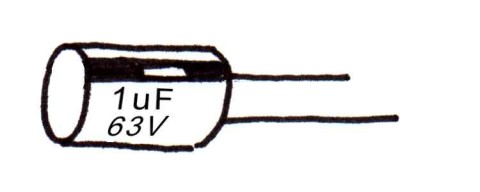Most electrical and electronic components use capacitors. In fact, capacitors are one of the main components in electronics! In this activity we will learn how to read the capacitor values.
Units
- 1F = 1 Farad
- 1uF = 1 x 10-6 Farads
- 1nF = 1 x 10-9 Farads
- 1pF = 1 x 10-12 Farads
The amount of capacitance is measured in units called Farads (F). A higher capacitance results in a greater storage capacity, much like having a bigger water bucket. One Farad is very big. A 1 Farad Capacitor is about 3″ in diameter and about 10″ long. Because a Farad is so big, we must use smaller units.
The most common types of capacitors used in the highschool are:

Electrolytic |

Ceramic |

Film |
Like resistors, many capacitors are so physically small their value must be identified by a code.
These capacitors will always be labeled with their value of capacitance, but they may also be labeled with:
- Voltage
- Tolerance
- Temperature properties
Although the purist would notice that I will ignore a lot of the information available on the capacitors, for all intents and purposes at the highschool level, I don’t use them.
Cracking the Code
Electrolytic capacitors are the easiest to identify. They are so large, that the value is written right on them.
For film and ceramic capacitors, there are four methods to identifying the value of the capacitor.
If the value is a two digit whole number (ie: no decimal), then the value is exactly as it is written. These will always be in pico Farads.
“10” = 10pF
If the value is a three digit whole number, then the value is much like resistors, where the third digit is the multiplier. These will always be in pico Farads.
“104” = 100,000pF (0.1uF)
If the value is a decimal number, then the value is exactly as it is written. These will always be in micro Farads.
“.1” = 0.1uF
If the value is a whole number followed by an “n”, then the value is exactly as it is written. These will always be in nano Farads.
“100n” = 100nF
Reading Voltage
You may find that some capacitors have an additional number. This is the voltage rating of the capacitor. Not all capacitors are labeled with the voltage rating. It is always important to select capacitors with a higher voltage than what the circuit will be using. Ka-boom.
Reading Tolerance
- B = +/-0.10%
- C = +/- 0.25%
- D = +/- 0.5%
- E = +/- 0.5%
- F = +/- 1%
- G = +/- 2%
- H = +/- 3%
- J = +/- 5%
- K = +/- 10%
- M = +/- 20%
- N = +/- 0.05%
- P = +100%,-0%
- Z = +80%,-20%
You may find that some capacitors have an additional letter, sometimes even where you would expect the “F” for Farad. This is a code for the tolerance, or accuracy of the value. “K” is a common tolerance in some of our capacitors.
Electrolytic capacitors are not usually labeled with their tolerance. They are commonly accepted to be -20% +100%.

